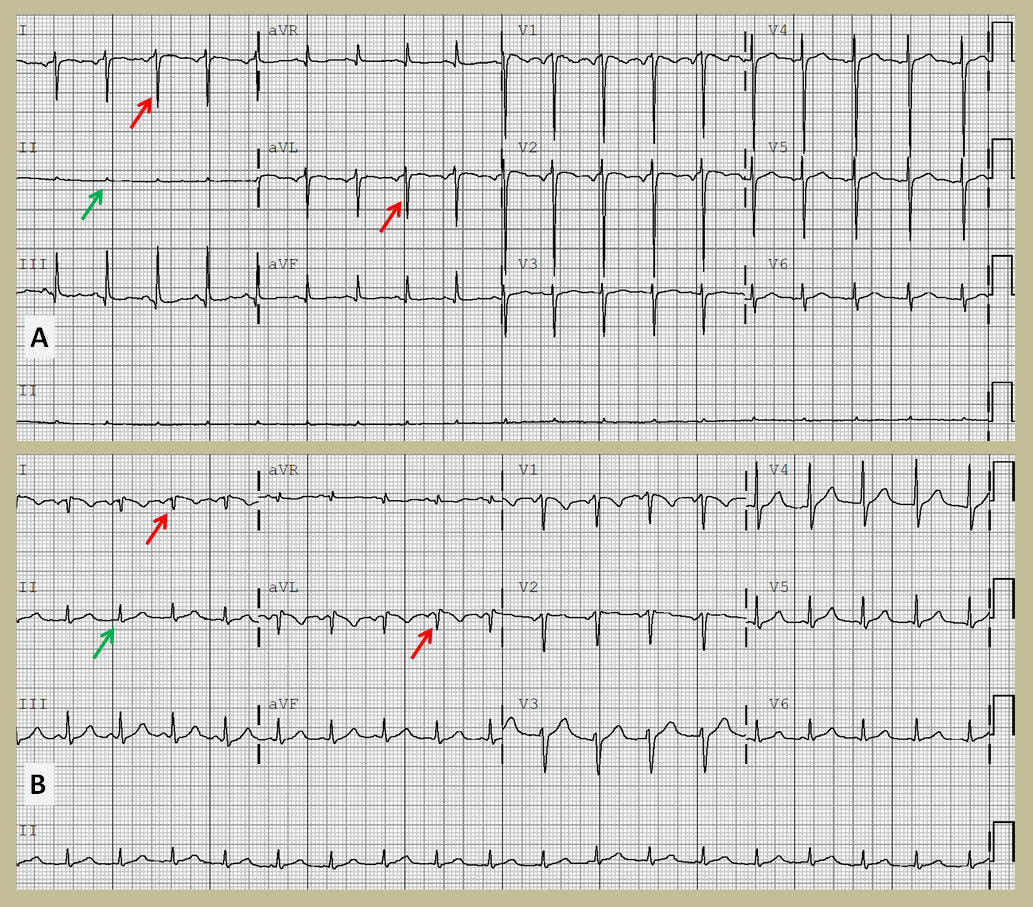June 2024 Issue
ISSN 2689-291X
ISSN 2689-291X
Arm Lead Reversal Look-Alike:
Grounding Artifact!
Description
The above two EKGs represent lead reversals, with a negative P-wave and QRS direction in leads I and aVL (red arrows). There is no evidence of dextrocardia, given concordance of aVR and V6 supportive of lead misplacement and proper precordial R wave progression.
At first glance, the likely cause for the lead reversal is arm lead misplacement, which is one of the more common lead placement errors encountered. However, closer scrutiny of the EKGs reveals near flattening of lead II in EKG A (green arrow), which is caused by right arm and right leg (RA – RL) lead reversal, or grounding artifact. EKG B, however, is a true arm lead reversal where leads II (green arrow) and III are intact but reversed.
Discussion
EKG recording errors are infrequent [1, 2] but can lead to poor quality and patient safety outcomes. Algorithms can be used to infer the type of lead reversal [3], which is crucial in identifying whether the error is due to faulty connection at the patient level [4] or at the machine levels [5], especial when certain errors are perpetual.
EKG-reading systems are helpful in recognizing some lead placement errors; however, they seem to attribute the error in both EKGs presented here to arm lead misplacement. Vigilance is called for when interpreting EKGs, especially in a busy practice, to be able to distinguish between such errors and implement timely remedy.
References
The above two EKGs represent lead reversals, with a negative P-wave and QRS direction in leads I and aVL (red arrows). There is no evidence of dextrocardia, given concordance of aVR and V6 supportive of lead misplacement and proper precordial R wave progression.
At first glance, the likely cause for the lead reversal is arm lead misplacement, which is one of the more common lead placement errors encountered. However, closer scrutiny of the EKGs reveals near flattening of lead II in EKG A (green arrow), which is caused by right arm and right leg (RA – RL) lead reversal, or grounding artifact. EKG B, however, is a true arm lead reversal where leads II (green arrow) and III are intact but reversed.
Discussion
EKG recording errors are infrequent [1, 2] but can lead to poor quality and patient safety outcomes. Algorithms can be used to infer the type of lead reversal [3], which is crucial in identifying whether the error is due to faulty connection at the patient level [4] or at the machine levels [5], especial when certain errors are perpetual.
EKG-reading systems are helpful in recognizing some lead placement errors; however, they seem to attribute the error in both EKGs presented here to arm lead misplacement. Vigilance is called for when interpreting EKGs, especially in a busy practice, to be able to distinguish between such errors and implement timely remedy.
References
- Awan M, Omar M, Omar B, Malozzi M, Awan A. ECG Recording Errors Prevalence in a Hospital Setting. Circulation: Cardiovascular Quality and Outcomes. Volume 11, Number suppl_1. 244.
- Moses A, Malozzi m, Omar B. Prevalence of ECG Recording Errors in a University Hospital ECG Database. Circulation: Cardiovascular Quality and Outcomes. Volume 9, Number suppl_2. 236.
- Abi-Saleh B, Omar B. Einthoven's triangle transparency: a practical method to explain limb lead configuration following single lead misplacements. Rev Cardiovasc Med. 2010 Winter;11(1):33-8.
- García-Niebla J, Llontop-García P, Valle-Racero JI, Serra-Autonell G, Batchvarov VN, de Luna AB. Technical mistakes during the acquisition of the electrocardiogram. Ann Noninvasive Electrocardiol. 2009 Oct;14(4):389-403.
- Batchvarov VN, Malik M, Camm AJ. Incorrect electrode cable connection during electrocardiographic recording. Europace. 2007 Nov;9(11):1081-90.
Authors:
Mustafeez Ur Rahman, M.D.
Cardiology Fellow
University of South Alabama
Mobile, AL
Mariam Riad, M.D.
Cardiology Fellow
University of South Alabama
Mobile, AL
Nupur Shah, M.D.
Cardiology Fellow
University of South Alabama
Mobile, AL
Celestine Odigwe, M.D.
Cardiology Fellow
University of South Alabama
Mobile, AL
Brent Ruiz, M.D.
Cardiology Fellow
University of South Alabama
Mobile, AL
Hajira Malik, M.D.
Cardiology Fellow
University of South Alabama
Mobile, AL
Bassam Omar, M.D., Ph.D.
Professor of Cardiology
University of South Alabama
Mobile, AL
Christopher Malozzi, D.O.
Associate Professor of Cardiology
University of South Alabama
Mobile, AL
Mustafeez Ur Rahman, M.D.
Cardiology Fellow
University of South Alabama
Mobile, AL
Mariam Riad, M.D.
Cardiology Fellow
University of South Alabama
Mobile, AL
Nupur Shah, M.D.
Cardiology Fellow
University of South Alabama
Mobile, AL
Celestine Odigwe, M.D.
Cardiology Fellow
University of South Alabama
Mobile, AL
Brent Ruiz, M.D.
Cardiology Fellow
University of South Alabama
Mobile, AL
Hajira Malik, M.D.
Cardiology Fellow
University of South Alabama
Mobile, AL
Bassam Omar, M.D., Ph.D.
Professor of Cardiology
University of South Alabama
Mobile, AL
Christopher Malozzi, D.O.
Associate Professor of Cardiology
University of South Alabama
Mobile, AL

